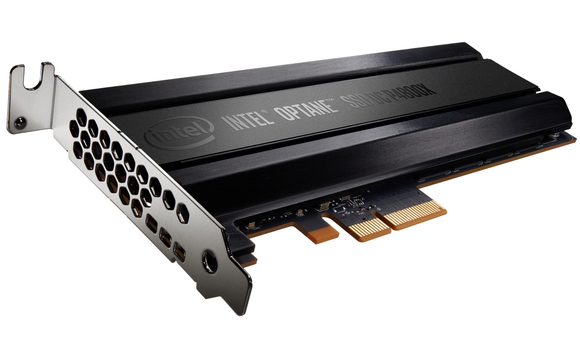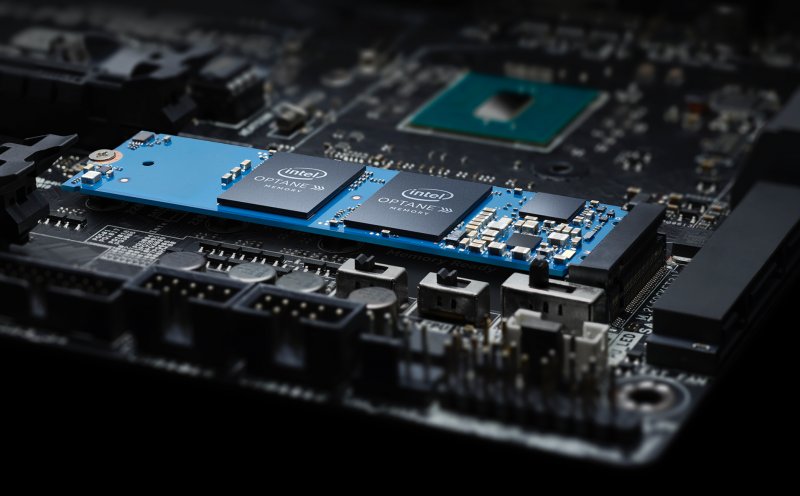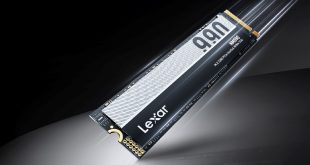Following on from last month's announcements, this week Intel's first 3D XPoint products officially became available. For the budget-oriented market, there is Optane Memory, a small M.2 cache drive intended to boost mechanical HDD performance, meanwhile for data-centres, Intel has the Optane DC P4800X, a super speedy PCIe SSD built using 3D XPoint memory.
The Optane DC P4800X is roughly five to eight times faster than many leading SSDs and should help fill the gap created by DRAM shortages. According to Intel, this drive is particularly ideal for “critical applications with aggressive latency requirements”. This makes sense, as 3D XPoint is built to offer extremely low latency while being built to last. In terms of read and write speeds, this SSD offers up to 2GB/s over a PCIe connection. It consumes around 14 watts under heavy load, making it very power efficient, another thing that is increasingly important for server farms and data centres.
This particular SSD will be available directly through Intel, with the 375GB version costing $1520. In the future though, there will be 750GB and 1.5TB versions.
For those who don't have thousands of pounds, there is Optane Memory. These 16GB or 32GB M.2 cache SSDs cost $44 and $77 respectively and are intended to help speed up boot and load times for users who only have a mechanical hard drive to work with. According to Intel's own stats, Optane Memory should provide up to a 67 percent performance boost when paired with a HDD.
The let down here is that Optane Memory compatibility is limited to 200-series motherboards and Kaby Lake (or newer) processors. So unless you're building a budget system right now in 2017, then you may not be able to use this new tech at all. You can check the full list of compatible motherboards and CPUs, HERE.
KitGuru Says: 3D XPoint sounds like interesting technology, though it doesn't seem like it is going to take over the consumer market just yet.
 KitGuru KitGuru.net – Tech News | Hardware News | Hardware Reviews | IOS | Mobile | Gaming | Graphics Cards
KitGuru KitGuru.net – Tech News | Hardware News | Hardware Reviews | IOS | Mobile | Gaming | Graphics Cards





Wow BS PR coming from Intel big time 😀 am i missing something with this? I have 750 series Intel SSD, which is quite close to theoretical numbers of optane SSD at a fraction of cost. And when you factor into that MS OSs and huge majority of games don’t really see much of improvement beyond SATA SSDs Intel is in a pickle here. And then you remember what they actually promised from this technology back in the day. Oh dear 😀
What about the latency? I doubt it comes even close to the latency of the Optane.
Em, 750 series typical latency stated is 20microseconds. Optane 10microseconds. Yes it’s halved, but again farcry of all the marketing fluff from the past.
Obviously price point can be explained due to p4800x being enterprise SSD.
But all this release stinks big time
I seriously doubt you’ll see 750 Series any close to this when talking about heavy load.
My issue is less with current stated performance numbers, and more with how they are going about it and how they hyped it before. Even though on paper in current state Optane looks quite a step up even from Intel’s previous SSDs, but from what it was talked to be it seems now like a complete failure technology wise.
My last paycheck was $22500 for working 12 hours a week online.Start earning $97/hour by working online from your home for few hours each day with GOOGLE… Get regular payments on weekly basis… All you need is a computer, internet connection and a litte free time… Read more here
!wr153c:
➽➽
➽➽➽➽ http://GoogleFinancialCashJobs153ExpertToday/GetPaid$97/Hour… ★✫★★✫★✫★★✫★✫★★✫★✫★★✫★✫★★✫★✫★★✫★✫★★✫★✫★★✫★✫★★✫★✫★★✫★✫★★✫:::!wr153u:…..